
Recently on Cyclingnews.com |
On test: Van Dessel Jersey Devil HT, August 15, 2007
The little company from New Jersey makes it big…29" big
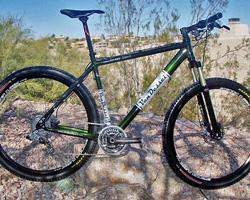
|
Van Dessel Cycles is a relatively small-bit East Coast player in terms of sales figures, but its relative visibility suggests that it plays with a big bat. Super-sized Cyclingnews' super-photographer Jonathan Devich tosses a leg over the Jersey Devil HT to get a feel for himself as to just what the company has to offer.
I should first preface this review by saying that I need things big. At 1.9m and 102kg (6'4" and 225lb), I wear extra-large sizes in just about everything. I wear big shoes (bless you, Sidi). I carry a big camera (two of them, in fact, on most occasions) and drive a big truck. Correction: make that huge, almost to the point of needing to carry around a small stepladder to facilitate the ingress and egress of my more vertically-challenged Cyclingnews coworkers. Remember that scene from Jurassic Park with the glass of water? That was me walking around the studio. Some scholars have even suggested that 'Goliath' actually translates to 'Jonathan' in some lesser-known idioms. And yes, I am wary of neighborhood kids wielding slingshots.
Even so, when I pulled the Van Dessel Jersey Devil HT out of its box I thought something must be wrong. Had I landed in an Alice in Wonderland video where everything had been grossly oversized? This bike was enormous, yet it was light, too. How could this be?
Meet the Devil
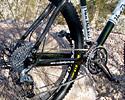
|
The hull of the Jersey Devil HT is formed from triple butted 7005 aluminum, neatly bonded to a vibration-damping carbon fiber seatstay assembly. Van Dessel opted to keep the chain stays aluminum, which I felt was a good durable choice, and these terminated in some very cleanly machined dropouts to polish off the rear end and tie everything together. Minimal, but seemingly well-placed, gussets provide additional strength and rigidity where needed, and the entire package is sheathed in a trick British racing green finish.
Coming from a neutral-handling full-suspension trail bike, the frame geometry was not quite what I was used to but I just about never fit in the "average" category for bike sizing anyway (see preface above). The 62cm (24.4") top tube required a 120mm-long stem, and the steep 74° seat angle begged for a setback post. Likewise, the 72.5° head tube angle sounded steep, but paired with the standard offset of the included 29" fork it yielded a fairly standard trail.
Van Dessel set up the test machine with one of its off-the-shelf "race build" kits, including carbon fiber cranks, seatpost, stem, and handlebars from FSA. The drivetrain consisted of American Classic wheels, SRAM X.0 trigger shifters and rear derailleur, Hayes El Camino brakes, and a White Brothers Magic 29 fork. This mix of parts provided a sturdy and capable race-ready bike straight out of the box with some room for improvement if deemed necessary or just as easily none if you couldn't be bothered.
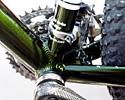
|
As built, the complete bike (without pedals) weighed just 10.9kg (24.0lb), no doubt aided by the claimed 1650g (3.64lb) claimed weight for a large frame. That figure would be respectable for most higher-end 29ers, let alone an XL, and was a noticeable improvement over the medium travel full-suspension XC bike I had been riding. With the cool factor placed aside, however, I was still skeptical about my first ride on the Jersey Devil HT, not only for its unreassuringly feathery weight but also as it would be my first experience on 29" wheels. Would the bigger hoops really make that much of a difference and would that little bit of carbon out back even be noticeable?
Taming the Devil
So far the shiny new Van Dessel was looking good on paper but it was time to see if the Devil could be ridden out of its east coast element. Arizona's unforgiving desert trails provided the backdrop for the true test of what the Devil was made of.

|
Immediately after getting on the bike I could feel how light and stiff it was, and while the 29" wheels seemed slightly awkward compared to my regular 26ers they rolled noticeably well. This all felt great initially but I was still skeptical as to how it would work on the trails.
To be honest, I wasn't impressed my first time out. I felt like the bike was too twitchy and I tended to overcorrect the steering when I got into the tight stuff. On the descents, I felt that the twitchiness was exaggerated to the point where I would just slow down for fear of a tumble.
After my third time out on the Jersey Devil, however, the clouds parted and a light shined down. I first noticed a change on a favorite rocky climb where the rear tire grabbed the rocks relentlessly no matter how much they tried to kick it off the trail. The 29er wheels were grabbing much better than I had expected and even made the going easier as they simply rolled over the small- and medium-sized rocks instead of getting hung up on them like the 26" wheels back in the garage. After bombing a small decent without any hesitation my confidence in the Van Dessel grew.
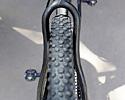
|
More saddle time on the Van Dessel brought out more of its promised qualities as it quickly became a lightweight, quick handling, fast rolling, and great climbing machine. Granted, it took some time getting used to the 29" wheels and going back to a hard tail XC racer but once I made that transition the bike felt spot on. After riding 29" wheels I don't know how I will go back to riding anything else; being a rider of my size, they just make more sense. Once I was used to them, tight singletrack was no issue, something I was particularly curious about, and the racier geometry kept even the most technical sections in check. The stiff rear end and different-feeling acceleration of the larger wheels also felt more roadish to me, which I appreciated. Blasting down fire roads were… well, a blast. Anywhere where you can crank up the speed on the Van Dessel brings a smile to the face.
What the Van Dessel was not was a long distance cruiser. The carbon fiber handlebars, seatpost and seat stays do take the edge off of things as they are supposed to, but after four hours on the race-oriented Van Dessel-branded saddle, I was definitely ready for a break. For shorter rides (and for most average XC races), though, the Jersey Devil HT's ride quality was still better than its appearance suggested. Speaking of appearances, the paint also chipped far easier than I would have preferred.
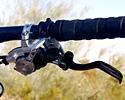
|
Tuning the White Brothers Magic 29 fork was simple and quick, and provided just enough bump absorption to keep things comfy. The SRAM transmission performed similarly flawlessly: shifts were dead-on under all conditions I could throw at it and only minimal adjustments were needed over the decidedly abusive test period. The same could not be said of the FSA crankset, though. After just a few long rides, the non-driveside arm nearly fell off. The outer cap that retains the crank bolt was missing and the crank bolt itself was just about to go AWOL, too. After tightening the crank bolt I then noticed that the bottom bracket bearings had some major play in them as well. A bearing replacement solved that problem but the non-tapered spline on the FSA spindle just wouldn't stay tight. Thankfully, FSA has introduced a tapered spline on its newer models that should prove more durable.
Another issue that came up during the adjustment period was a finicky reach adjuster screw on the Hayes El Camino brakes. On just one ride, the screw backed out nearly completely even though it had the factory-applied thread retaining compound on it; a more liberal application of the stuff eventually fixed that problem. This wasn't a huge issue at the time but easily could have been had its mating barrel in the lever dropped out of sight an hour away from anywhere (thus rendering the brake useless). Otherwise, the El Caminos worked smoothly and predictably, and Van Dessel has reportedly also revised the chain stay-located rear brake caliper mount to improve compatibility with certain brands.
Rating the Devil
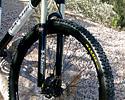
|
All in all, the Van Dessel Jersey Devil HT was a surprisingly entertaining and capable ride. After getting used to being back on a hardtail and the new-to-me 29ers, I fell in love with this bike. Fire roads were fast and fun, descents (whether steep or technical) posed no real issue and the Jersey Devil HT ripped through technical sections like the wild beast that it is. The low weight was a big help with the fun factor and if you're a weight freak you could easily bring that number down even lower. After my experiences with the carbon FSA cranks, though, I would definitely consider something more reliable, especially if you're a bigger rider. But with a great mix of components right out of the box, low weight, good build quality, and a spectacular ride, the Jersey Devil HT should certainly fall on most rider's short list of 29" XC hardtails.
Price: US$3999 (as built); US$899 (frame and headset only)
Weight: 10.9kg (24.0lb)
Pros: Light weight, good climbing ability, and quick handling. 29" wheels
are a perfect fit for us bigger guys.
Cons: FSA crankset bearings wore out very quickly and the crank arm bolt
would not stay tight.
Cyclingnews rating: ![]()
Photography
For a thumbnail gallery of these images, click here
Images by Jonathan Devich/epicimages.us
- The Van Dessel Jersey Devil HT is an excellent example of a well-done 29" hardtail.
- Bigger IS better.
- Clean welds hold everything together at the bottom bracket.
- For 2008 Van Dessel will modify the rear caliper mount to accept a wider range of makes and models.
- A cleanly welded head tube gusset reinforces the front end.
- FSA kept up well with the navigational duties.
- Van Dessel provided the Jersey Devil HT will reasonable tire clearance to clear mud.
- The nicely appointed drivetrain of the Van Dessel race spec Jersey Devil HT.
- Carbon seat stays help to keep the ride stable yet comfortable.
- Those 29" wheels are huge , making the 32mm stanchions on the White Brothers fork almost look small.
- The hollow box-section crown on the White Brothers fork helps to keep things relatively stiff up front.
- The carbon seat stays fit neatly into the front aluminum triangle.
- An FSA carbon seatpost provides further vibration damping.
- American Classic wheels held up very well on the rocky terrain. The Maxxis Ignitor tires hooked up great, but be ready for all the rocks they kick up at you or your buddies.
- SRAM X.0 thumb shifters feature an adjustable pull lever for a customizable fit.
- Clean cable routing keeps them up and out of the way of mud.
|
Frame: Van Dessel Jersey Devil HT, triple butted 7005 aluminum
with carbon fiber seat stays |
Shift levers: SRAM X.0 trigger |

